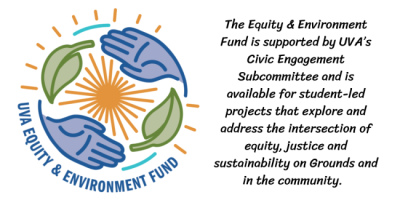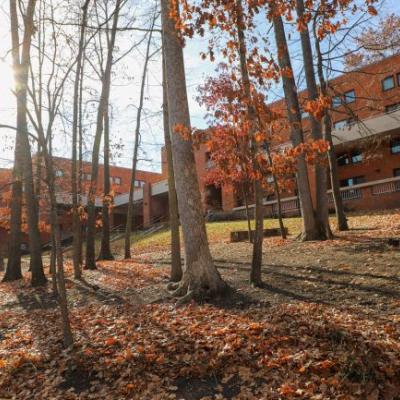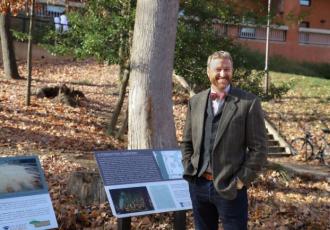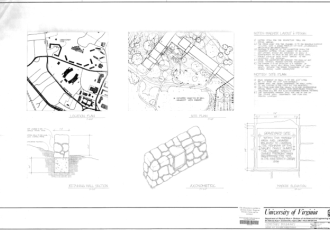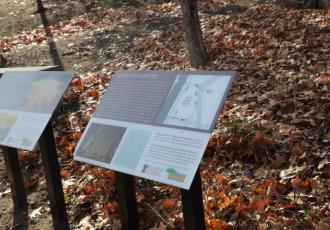
They never met each other, but thanks to an elderly woman who shared her story in 1983 and a UVA student who spoke up at a meeting in 2018, we now understand more about a historic site on Grounds.
It's easy to overlook - a patch of nondescript ground in front of Gooch Dillard Hall, some trees and mulch, a few sections of low stone wall on the edge. Fixed into one of those walls is a stone plaque from the year the dorms were built:
Graveyard Site: This area contains unmarked graves believed to be those of slaves of the Maury family, owners of the Piedmont in the nineteenth century. University of Virginia. 1984.
For decades, students cut across the dirt patch on their way to and from classes, likely unaware - or uncaring - that they tread upon hallowed ground. But in 2018, a student who had seen that stone plaque stood up at a Student Council meeting to voice concerns that people were desecrating the burial grounds.
"This was something we decided could be an action item that could be accomplished," says Andrew Williams, a council member at the time and now working in New York City. A received a grant through UVA’s Equity & Environment Fund, which supports projects that explore the intersection of social equity and environmental sustainability.
But what should the signs say? The question raised a hundred others and led them on a months-long journey.
Getting it right
They reached out to history professor Louis Nelson, Vice Provost for Academic Outreach and member of the UVA President's Commission on Slavery and the University.
"The students were really motivated to make this happen, not just a website or a paper, they wanted to re-shape the landscape itself so future students wouldn't be as surprised by this story," Nelson says. "So many people, frankly, think of the Old South as something that is removed. Having interpretive signs in spaces like this help us do the work of remembering we actually live in that landscape that is that legacy."
It was important to ensure the text on the signs was accurate and appropriately contextualized, reflecting the growing acknowledgement of the broader history of the land upon which the University sits, Nelson says. But the task was tricky because information about slave burial sites is generally absent from written records.
The students found some helpful documents in the Special Collections Library, including a site survey by university researchers in 1982 when the dorms were being planned. "It's actually surprising that a university would do an archaeological survey on a building site in 1982," says Kirt von Daacke, history professor and co-chair of the slavery commission then and now.
The students also found letters from the Maury family that once owned that patch of land and enslaved people.
The story within
The land was part of a grant from King George III in 1772 to Dr. Thomas Walker. The property changed hands several times before it was sold to UVA in 1948.
The 1982 survey revealed sites of two former houses, but there was no mention of graves. A year later, more work was done based on information from Alice H. Clark, 79, a community member who lived nearby. Hearing about the impending construction work on Grounds, Clark contacted the researchers and said the area was part of the former 2,300-acre Piedmont plantation once owned by her grandfather, Jesse Lewis Maury.
"Mrs. Clark remembers that there were once upright stones marking the graves, but those have been either stolen or covered by vegetation over the years," the 1983 survey reads. Through soil characteristics, ground depressions and the presence of periwinkle, a non-native species often used in cemetaries, researchers identified nine grave sites, all oriented east-west, and estimated the site could hold between 75 and 175 graves. They determined the dorm construction would not impact the burial ground, and the stone walls demarcating the site and stone plaque were installed.
Inspiring others
Former Student Council member Williams says the text and design of the cemetery signs went through many iterations, vetted by multiple UVA officials and scholars, including von Daacke who also connected the students with The Daughters of Zion Cemetery in Charlottesville. "The students definitely deserve credit for pushing through on this, taking to people and securing funds," von Daacke says.
Williams says that having the Equity & Environment Fund grant to make the signs allowed the students to focus on the content and without which, they might not have pursued the project. "I would definitely encourage students to consider applying, no matter how small or big their idea," he says. "It's a great way for student projects to happen."
Third-year student Kyndall Walker may do just that. She did a tour of Grounds with Professor Nelson in 2019 and seeing the new signs at Gooch Dillard, recalls thinking: "It's not sufficient. There needs to be more to make sure students know about these sites around the school."
Due to the separate placement of the signs, students were only getting part of the story. Walker and other students formed History of Enslaved African-American Laborers at UVA (HEAAL UVA) and got 300 signatures on a letter to the University leadership calling for more education about historical places.
Professor von Daacke provided funds from the President's Commission on the University in the Age of Segregation for a third sign that included some of the text HEAAL UVA had suggested. "The added sign made sure that no matter which way students interacted with the interpretive panels at the site, they read something that acknowledged the humanity of the enslaved buried there."
Walker says HEAAL UVA is now doing tours for all 1st-year students. She's considering applying for an Equity & Environment Fund grant for a teach-in, a resource fair and other events "so everybody can support each other in a lot of ways, to see how student activism shapes the built environment."
-By Cat McCue, Communications Generalist, UVA Office for Sustainability

